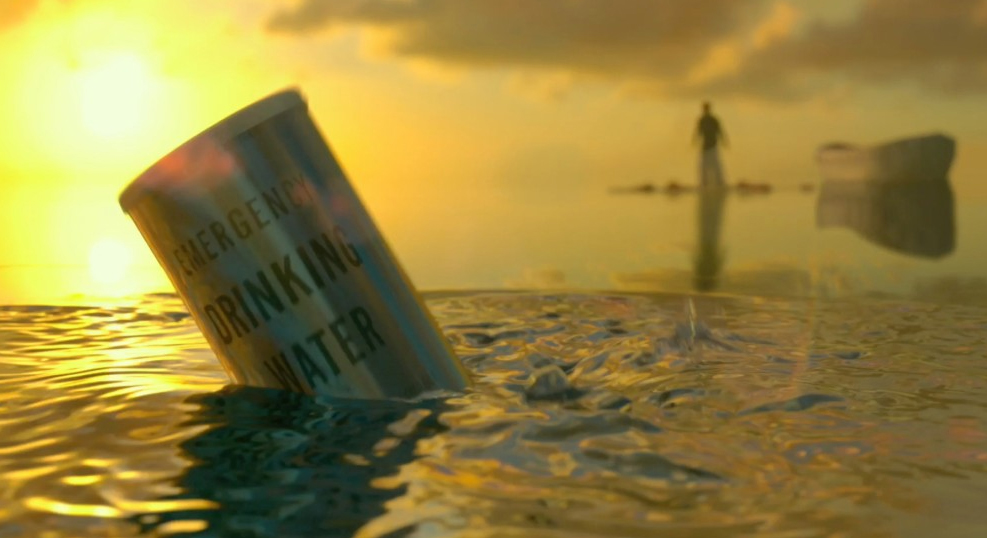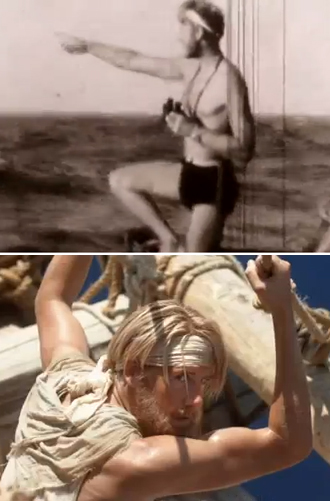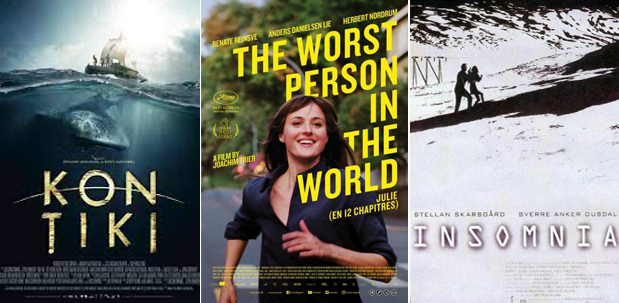It's less than 4 days until we're drowning in it! I was called to task a bit for the tsunami image from The Impossible that greeted my first "days until" Oscar nominations post a week ago. I understand the charge of insensitivity and I'll admit it was a weird judgment call. But I have been feeling not just metaphorically deluged. There is so much literal fear or water / drowning on screens this film season. Have any of you noticed? It didn't hit me at first since it's not a particularly visceral fear for me... I've always loved the water.
Let's recount each dive in this year...
 If Steven Soderbergh had filmed Life of Pi this would be the entire color palette!
If Steven Soderbergh had filmed Life of Pi this would be the entire color palette!
- Beasts of the Southern Wild -for Hushpuppy drowning is the end of the world, hurricanes as apocalypse. Those shots of drowned animals and her thoughts about them having no daddies? Heartbreaking.
- The Impossible - tells a true story of survival from the 2004 Thai tsunami. I still think it odd that it's visual effects and makeup did not make the finalists list for Oscars.
- Skyfall -Adele's killer theme song kicks in just as James Bond plunges into the water, presumably to rest in a watery grave... or at least to sink into the trippy watery grave visuals of the opening credits
- Oslo August 31st - this critical darling drama about an addict in recovery basically begins with the protagonist going all Virginia Woolf by loading his pockets with rocks and walking out into the water
- Life of Pi - at the center of an ungainly expository drama, is a miniature visual masterpiece about a shipwreck and a tiger and boy sharing a boat alone in the vastness of the ocean
- Jeff Who Lives at Home - stacks its coincidences one on top of the other to lead to a drowning rescue scene
- The Dark Knight Rises -- death by exile (SPOILER) exile being an icy watery grave
- Rise of the Guardians -- begins with an icy drowning
- Moonrise Kingdom features a big storm and flood
- Amour - has flooding but in which context we shouldn't say
- Rust & Bone - Marion Cotillard loses her legs in a killer whale accident in France's Sea World and there is also a drowning terror sequence
- Zero Dark Thirty -the waterboarding torture sequence is what keeps everyone talking though it's a tiny part of the movie. But still: horrific.
Last night, the Film Society at Lincoln Center showed two of the foreign language finalists (sort of*), Iceland's The Deep and Norway's Kon-Tiki, a double bill that was the equivalent of being tossed into the deep-end of this reccurrent theme. Both are true stories about men surviving the unsurvivable on ocean journeys.

Iceland's Oscar entry The Deep comes from Baltasar Kormakur (of 101 Rejkvjavik, Hafid/The Sea, and Contraband fame). It's both poetically moody and crudely matter of fact somehow. It's steeped in the inky blackness you'd expect from an ocean story at night. (I'm so pleased my screener didn't work because I can't imagine being able to see it at all outside of the movie theater). Hell, even before we hit the water we're in Iceland at night so you can image the darkness. We follow a group of fishermen around as they drink and drink prior to their next voyage. The awful shipwreck occurs relatively early into the movie and for such a simple reason it's surprising that any fishermen live to die from old age. The drowning sequences were, for me, horrific in their calmness, like watching people casually negated as the darkness envelops them. The Deep unfortunately loses its frost-bitten footing post-ocean trauma when there's a surprising amount of the movie left and we move into a sort of barely there invegistave procedura. But I appreciated The Deep for being very Icelandic (memories of volcanic eruption and a harsh life on the inky sea inform the drama throughout) and as a sort of shoestring non-magical-realist counterpoint to Life of Pi when a fat man begins to converse with a seagull, his only company. B
 Thor Heyerdhal (the real version) and Thor Heyerdahl (the movie version) played by Pål Sverre Valheim Hagen Norway's entry Kon-Tiki dramatizes the once very famous balsa wood raft ocean voyage of Norwegian explorer Thor Heyerdahl. I say 'once' because two of my friends in their 20s that I spoke to about the movie had no idea who he was or that it was a true story. I knew the whole story from childhood since my parents had a thing for National Geographic magazines (we had a huge collection) and PBS documentaries -- I think I must have even seen Heyerdahl's self-mythologizing Oscar winning doc Kon-Tiki as a child at some point since the story was so familiar.
Thor Heyerdhal (the real version) and Thor Heyerdahl (the movie version) played by Pål Sverre Valheim Hagen Norway's entry Kon-Tiki dramatizes the once very famous balsa wood raft ocean voyage of Norwegian explorer Thor Heyerdahl. I say 'once' because two of my friends in their 20s that I spoke to about the movie had no idea who he was or that it was a true story. I knew the whole story from childhood since my parents had a thing for National Geographic magazines (we had a huge collection) and PBS documentaries -- I think I must have even seen Heyerdahl's self-mythologizing Oscar winning doc Kon-Tiki as a child at some point since the story was so familiar.
I sat down all excited to see the most expensive Norwegian movie ever made about one of the most famous Norwegians who ever lived about a story I knew and was immediately disappointed when everyone began speaking in English -- even in scenes set in Norway or between an entire cast of Norwegians (and one Swede). We definitely got off on the wrong foot this movie and I. As it turns out the filmmakers shot each scene twice, once in Norwegian and once in English and the version that's hitting Stateside theaters is, in fact, NOT the Oscar-competing film but it's English-language doppelganger. So most of us will never get to see the film that Oscar voters saw.
I came for a Norwegian adventure movie and got a strange hybrid film that seemed like a big budget Disney movie that had appropriated a foreign story. Maybe the acting was better in its native tongue? There was something about the coloring book simplistic character arcs and super accessible Movie-Movieness that made this very true story feel artificial, negating much of its power. As eye candy, though, the movie is really something, with the amazing beauty of both the Ocean and towheaded shirtless Norwegians exploited throughout. (And just like The Deep it makes an interesting counterpoint to Life of Pi . As in Ang Lee's picture there are scenes featuring bioluminscent marine biology, violent animal deaths, and mass flying fish suicides on a boat). C+
 Monday, March 7, 2022 at 1:26PM
Monday, March 7, 2022 at 1:26PM 









